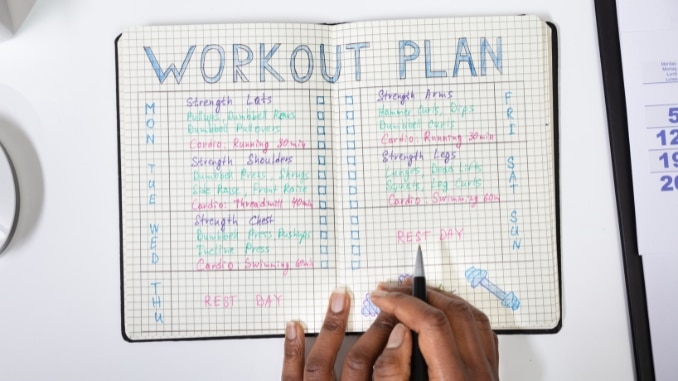Starting a new exercise program is exciting, but diving in too fast can cause injuries. It’s crucial to begin slowly and gradually increase your workouts to avoid setbacks and ensure long-term success. We’ll explain why is it important to ease into an exercise program and how to start effectively.
Importance of Easing into an Exercise Program
Starting an exercise program slowly is key for many reasons.
- Allows body to adopt – Starting slowly helps your body adjust to increased physical activity. It reduces the risk of injuries such as strains and sprains.
- Builds a Strong Fitness Base – Establishes a solid foundation for more intense workouts in the future. It enhances endurance and muscle strength gradually.
- Promotes Long-term Consistency – It is also important to ease into an exercise program because it helps in maintaining a consistent workout routine and encourages sustainable exercise habits.
- Reduces Risk of Burnout – Prevents overtraining and mental fatigue. Keeps you motivated by avoiding early exhaustion.
- Improves Overall Health and Fitness – Gradual increase in workout intensity and duration enhances cardiovascular health. Strengthens muscles, improves flexibility, and boosts metabolism.
- Customizes to Individual Goals and Fitness Levels – Tailoring a plan to your specific needs and capabilities ensures better results. Allows for setting realistic and achievable milestones.
- Incorporates Variety for Enjoyment – Mixing different activities, like classes or outdoor workouts, keeps exercise fun and engaging. Reduces monotony and keeps you motivated.
- Seeks Professional Guidance – Consulting fitness experts can provide personalized advice and safe exercise practices. Ensures proper form and technique, reducing injury risk.
A study from the American Geriatrics Society evaluated the Strong-for-Life home exercise program [1] for older adults. Results showed significant improvements, especially in men, with increased strength, energy, and mood. Thus, programs like Strong-for-Life can greatly enhance strength, flexibility, and overall well-being.
Flexibility Exercises
Start with simple stretching and slowly do more and stretch longer to get more flexible. Here are some flexibility exercises:
1. Hamstring Stretch
For this exercise, you may need a towel, a resistance band, or resistance tubing.
Begin in an upright sitting position on the floor with your legs extended in front. Maintain good alignment with your head, shoulders, and hips. Wrap the resistance tubing around your left foot, holding the ends on each hand. Engage your core and lift your left foot as you pull the resistance tubing towards you. You should feel a gentle stretch down the back of your leg. Hold the position for several deep belly breaths, in through your nose and out through your mouth. Relax and repeat the movement on the opposite leg.
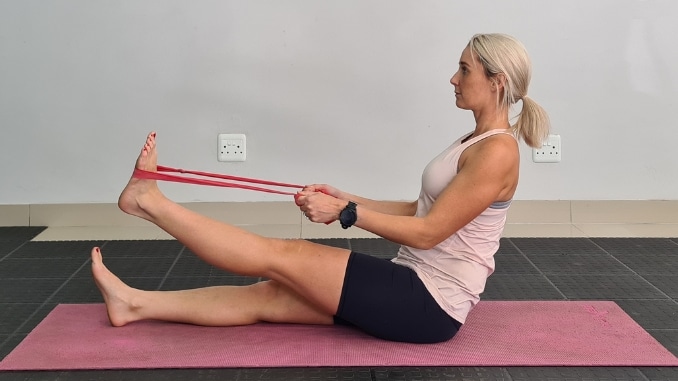
2. Cross Arm Stretch
Begin in an upright standing position with your feet shoulder-width apart, maintaining good alignment with your head, shoulders, hips, and legs. Contract your core. Reach across your chest with one arm and use your other hand to pull your arm closer to your body, looking for a light stretch. Hold this position for several deep belly breaths, in through your nose and out through your mouth. Relax and repeat the movement on the opposite side.
To intensify the exercise, open and close your fist for 5 repetitions. Take several deep breaths while you squeeze and release, in through your nose and out through your mouth.
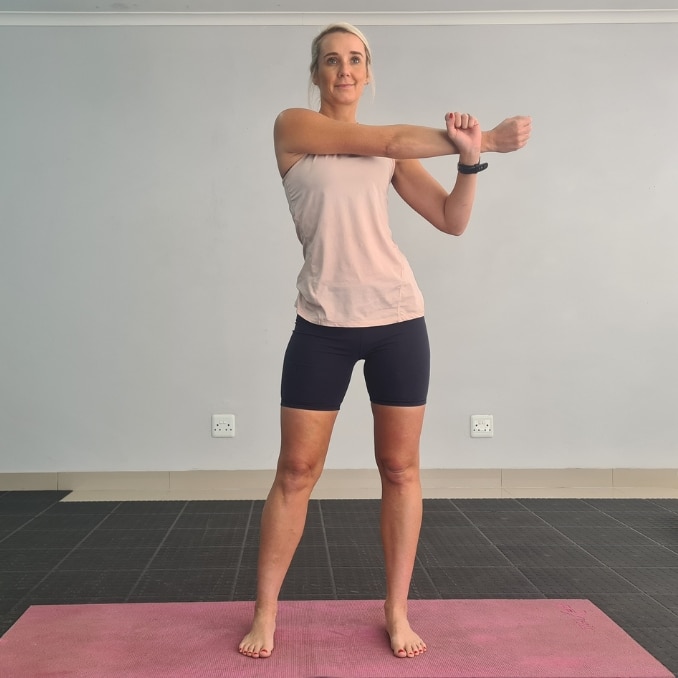
3. Hip Flexor Stretch
Begin in an upright standing position with your feet shoulder-width apart, maintaining good alignment with your head, shoulders, hips, and legs. Tighten your abdominal muscles. Take a step back with your left foot and slightly bend both knees lifting your left heel. Then, lower your heel down to the floor to straighten your left leg while keeping your right knee bent. Hold each position for a couple of seconds, Repeat the movement on the opposite side. Repeat the movement as needed.
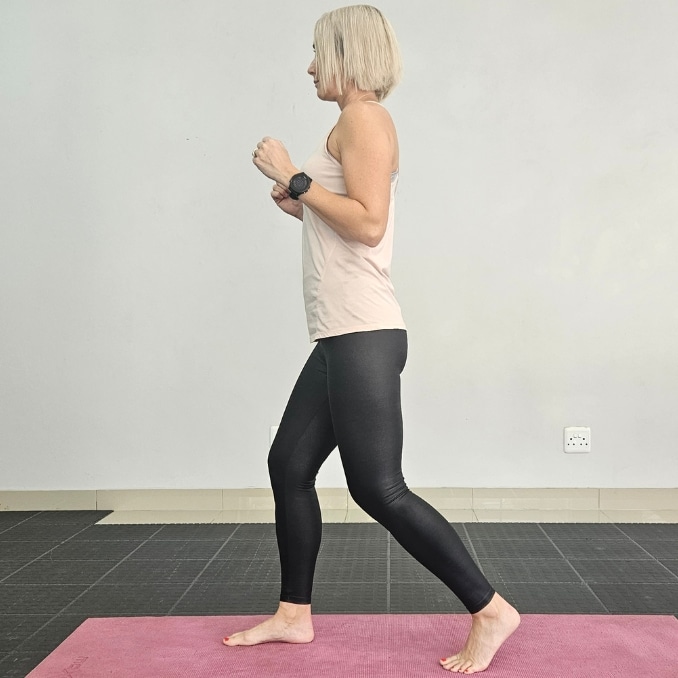 | 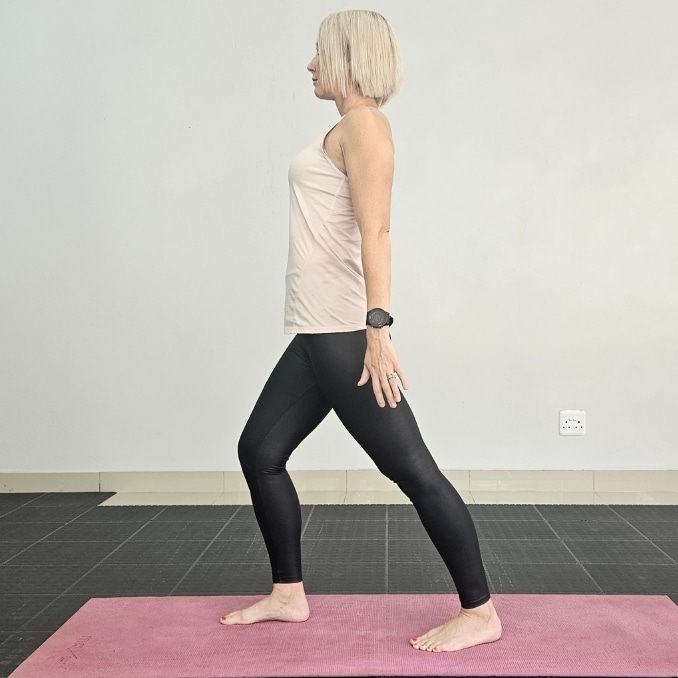 |
4. Seated Hip Forward Bend
Begin in an upright sitting position on the edge of a chair, with your legs extended in front wider than shoulder-width apart with your heels pressed on the floor. Place your hands at the side of the chair for support. Engage your core and hinge through your hips to bend your upper body forward, while keeping your legs and spine straight. Hold the position for several deep belly breaths, in through your nose and out through your mouth. Return to the starting position and repeat the movement with 2 sets of 10 repetitions.
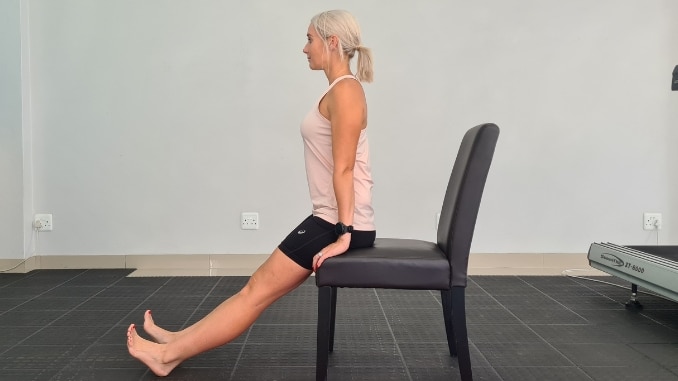 |
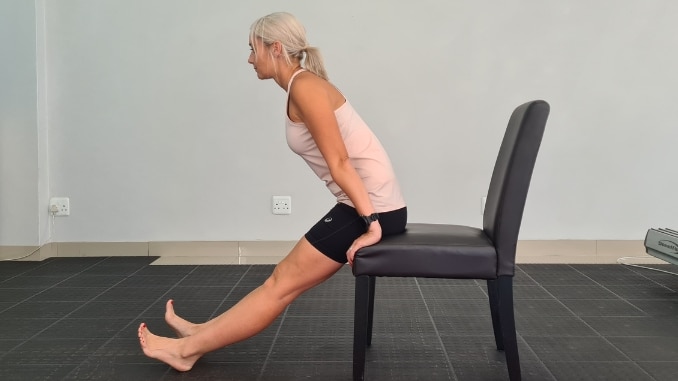 |
5. Cat-Cow
Begin in a 4-point position on the floor with your hands beneath your shoulders and your knees under your hips. Inhale and contract your abdominal area. Exhale and slowly round out your mid-back as you drop your head downward. Then alternate by inhaling as you slowly lift your head and arch your mid-back. Repeat the movement, alternating directions. Complete 3 sets in 5 repetitions.
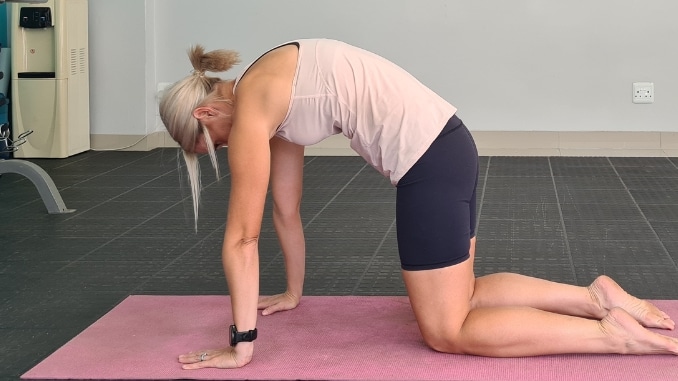 |
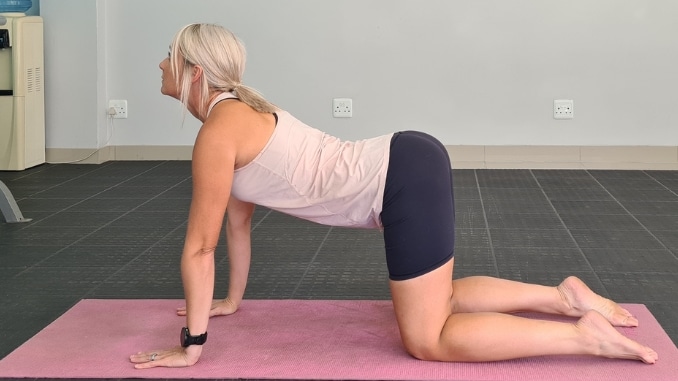 |
Gradual Progression and Its Impact on Injury Prevention
When starting a new workout routine, it’s best to go slow to avoid injuries. Gradually make your exercises longer, more intense, and more frequent. This helps your body adapt and get stronger, reducing the risk of injury by improving your flexibility and stability. Taking it slow ensures a safer path to better fitness. Proper progression prevents [2] overtraining and minimizes injury risk.
Gradual Exercise Plan: 10 Gentle Workouts to Start and Progress Safely

Here are some easy ways to start exercising at your own pace, gradually increasing intensity as you get fitter and more comfortable:
- Walking: Begin with brief walks at an easy pace and slowly extend the time and effort as you go.
- Jogging or Running: Start by mixing walking and jogging, then slowly run more as you get stronger.
- Cycling: Begin with short bike rides on flat ground and slowly add longer distances or hills to increase the challenge.
- Swimming: Start with simple laps or water aerobics and slowly increase your laps or do harder exercises in the pool.
- Strength Training: Start with light weights or simple exercises and slowly add more difficulty as your muscles get stronger.
- Yoga: Start with easy yoga poses and move to harder ones as you get stronger and more flexible.
Here are some easy yoga poses you can try to ease into an exercise program:
- Warrior I
- Tree Pose
- Bridge Pose
- Seated Forward Bend
- Corpse Pose
- Pilates: Start with basic Pilates exercises and gradually add more advanced movements and resistance over time.
- Tai Chi: Begin with simple Tai Chi movements and gradually learn more complex sequences as balance and coordination improve.
- Aerobic Classes: Start with low-impact aerobic classes and gradually progress to higher-intensity classes like step aerobics or dance workouts.
How to Ease Into an Exercise Program Effectively
- Baseline Assessment: Check your current fitness level by assessing your endurance, strength, , and body composition with tests like fitness checks and body analysis.
- Progressive Overload: Slowly make your workouts longer, harder, and more frequent to improve your fitness gradually.
- Individualized Program: To ease into your exercise program effectively, create your exercise plan based on your fitness goals, likes, and physical ability. Consider your age, health history, past exercise experience, and any current injuries.
- Periodization: Use a planned exercise schedule with different phases, each targeting a specific fitness area, like strength or endurance. This method helps improve performance, prevent workout plateaus, and reduce injury risks.
- Warm-up and Cool-down: Include warm-up and cool-down sessions in your workouts to prepare your body for exercise and help it recover afterward. Warm-ups loosen muscles, and cool-downs ease soreness.
- Functional Movement Patterns: Focus on exercises that are similar to everyday movements and sports actions. This helps improve muscle coordination, joint stability, and movement, lowering injury risk during exercise and daily activities.
- Proper Technique: Focus on correct exercise techniques to avoid injuries and make sure each move works well.
- Be attentive to your body: Another tip to ease into your exercise program effectively, pay attention to any tiredness or pain during exercise and adjust how hard or long you work out. Ignoring pain can cause injuries and slow your progress.
- Rest and Recovery: Include rest days and recovery time in your workout plan to let your body heal and avoid overtraining or injury.
- Nutrition and Hydration: Eat well and drink enough water to support your workouts. A balanced diet with the right mix of nutrients helps you exercise better and recover faster.
The Benefits of Allowing Your Body to Adapt to Exercise Gradually

1. Minimized Risk of Injury
Slowly increasing your fitness routine helps prevent injuries like strains and sprains. Gradually getting used to new activities makes your body stronger and safer for exercising over time.
2. Enhanced Strength
A slow-paced workout plan builds muscle strength and endurance. As muscles adjust to more work, they get stronger, enhance everyday activities, and lower injury risk.
3. Improved Endurance
Slowly increasing exercise helps your heart and lungs improve their ability to deliver oxygen to your muscles, allowing you to work out longer without getting tired.
4. Better Movement Patterns
Starting slowly with light exercises and focusing on proper form helps build good movement habits and muscle memory, reducing the risk of injuries.
5. Sustainable Progress
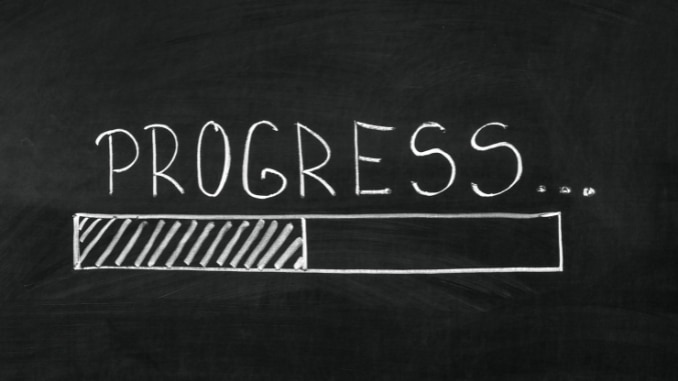
Slow and steady progress helps avoid injury and ensures long-term fitness success. Gradually increasing your workouts can lead to lasting health improvements.
6. Reduced Muscle Soreness
Slowly increasing exercise intensity helps reduce muscle soreness, limits damage, and speeds up recovery.
7. Improved Flexibility
Adding stretching and movement exercises to your workouts helps improve flexibility and movement, which can lower injury risk and boost joint health.
8. Enhanced Recovery
Taking enough rest and getting good sleep between workouts helps you recover better and lowers the risk of injuries and tiredness. This helps you stay healthy and keep improving in your fitness. Some research shows that exercise might help you sleep longer and better, but we need more studies to fully understand this.
9. Positive Mindset
Starting slowly builds confidence and motivation by allowing steady progress. Celebrating small wins and setting achievable goals helps maintain a positive mindset, making it easier to keep up with your exercise routine.
10. Long-term Success
Starting slow in your fitness journey leads to steady progress and long-term success. By focusing on small, steady improvements, you’ll make lasting changes to your health, enjoying a healthy and active lifestyle for years.
The Risks of Jumping Into Intense Workouts Without Proper Progression

Starting intense workouts too quickly can be harmful, especially if you have health issues like digestive or kidney diseases. Jumping into a new exercise program without considering your fitness level can lead to injuries.
It’s tempting to push too hard with fitness apps and strength training, but this increases the risk of injuries. Ease into workouts slowly and listen to your body to avoid harm. Regular exercise is good, but it’s important to be cautious and get professional advice.
- Increased risk of muscle strains and injuries
- Potential for overuse injuries like stress fractures
- Elevated risk of tendonitis and ligament sprains
- Higher likelihood of burnout and demotivation
- Possibility of exacerbating existing digestive and kidney diseases
- Potential for adverse effects on overall health due to excessive strain
- Risk of developing unhealthy exercise habits or patterns
- Increased susceptibility to fatigue and exhaustion
- Greater chance of experiencing setbacks or interruptions in your exercise journey
Conclusion
Starting an exercise program slowly has many lasting benefits. By being patient, you lower the risk of injury, letting your muscles and joints adjust. This method improves strength, endurance, and flexibility, promoting steady progress.
It also helps develop good movement habits, reducing soreness and fatigue. Plus, taking it slow boosts motivation and confidence, leading to long-term success in maintaining fitness and a healthy lifestyle.
What if I told you 11 gentle stretches could help you increase your energy, lose weight, decrease pain, stiffness and stress, and make you happier? Check out this 11 Daily Stretches to Feel and Look Amazing.

